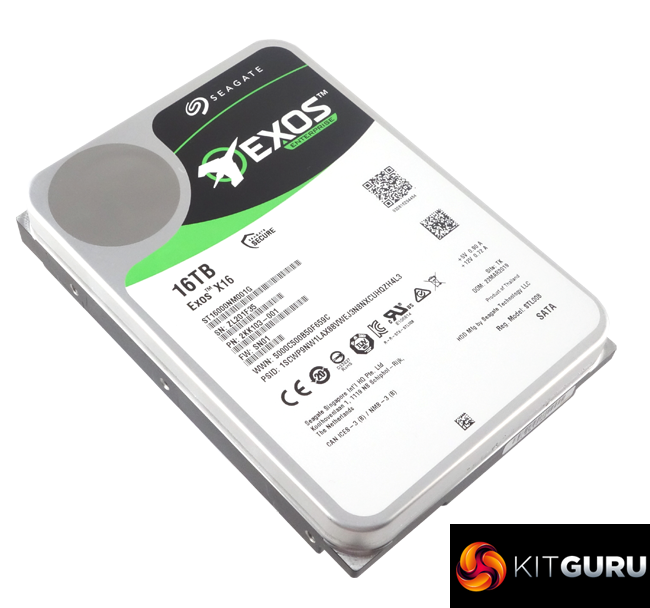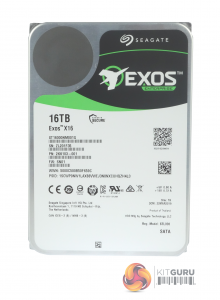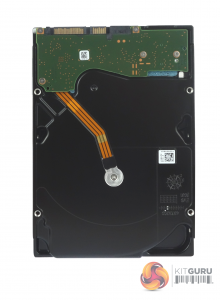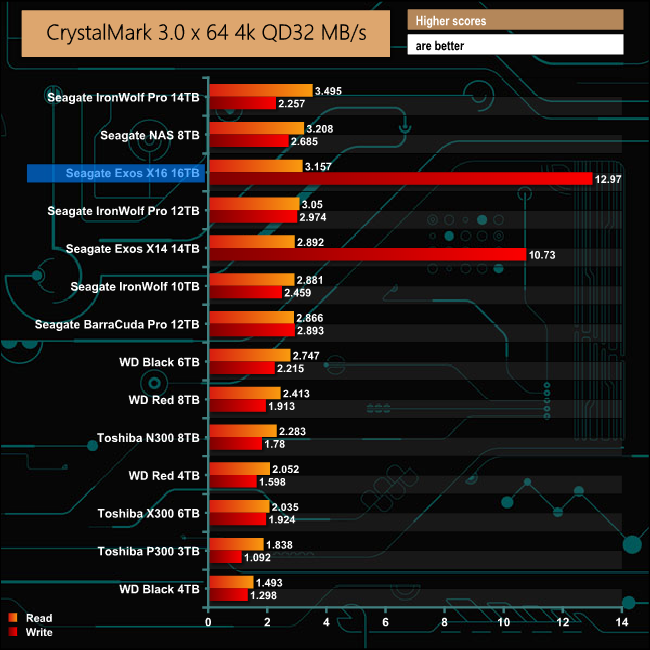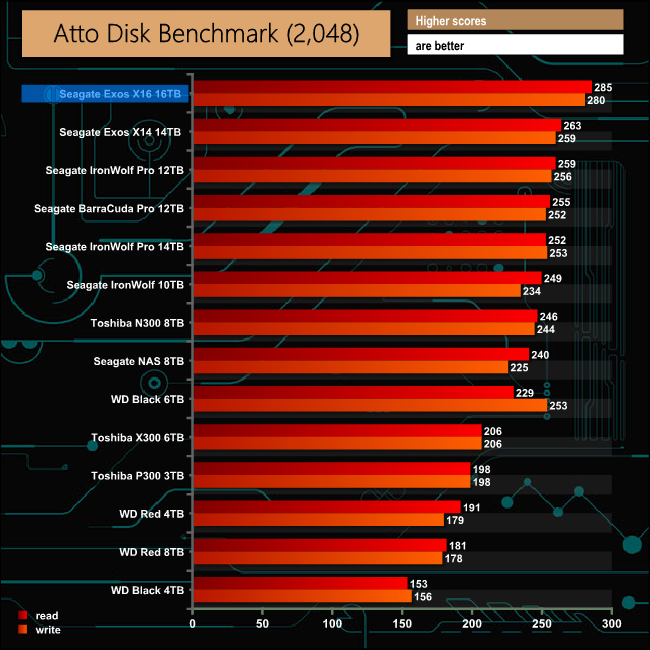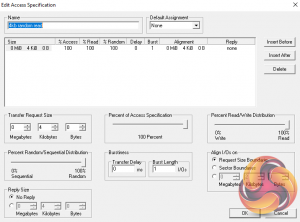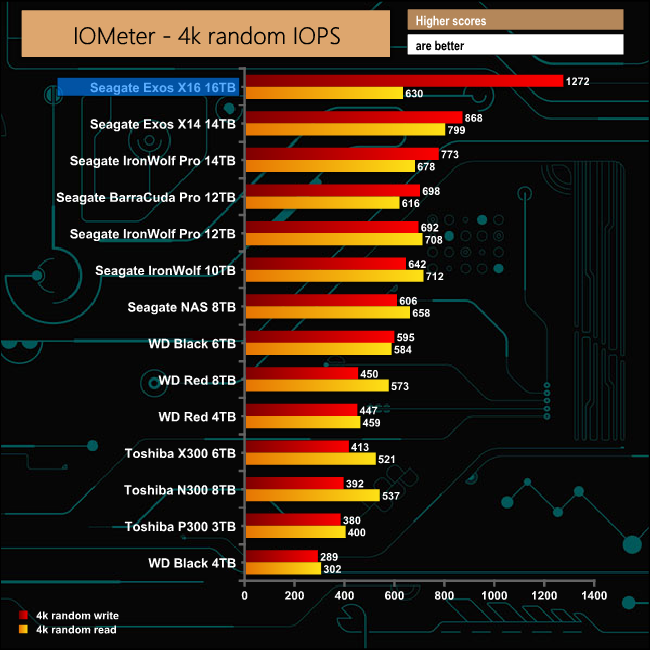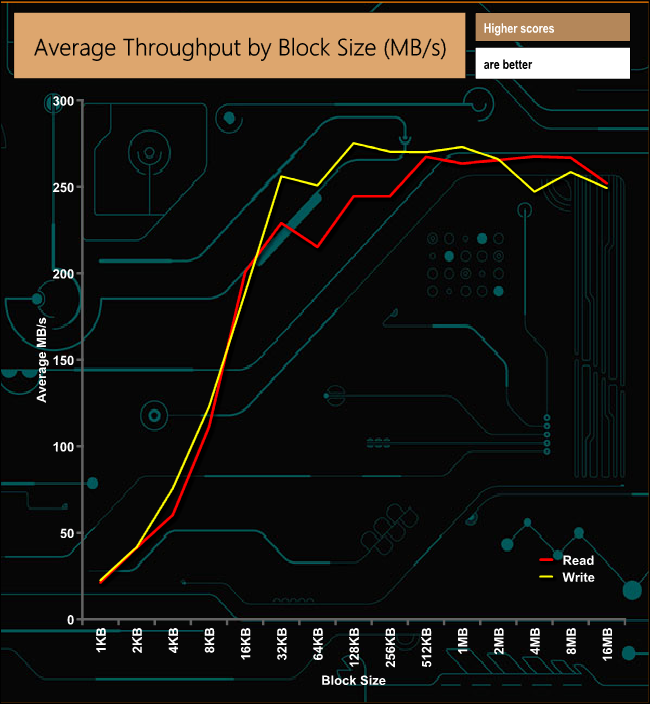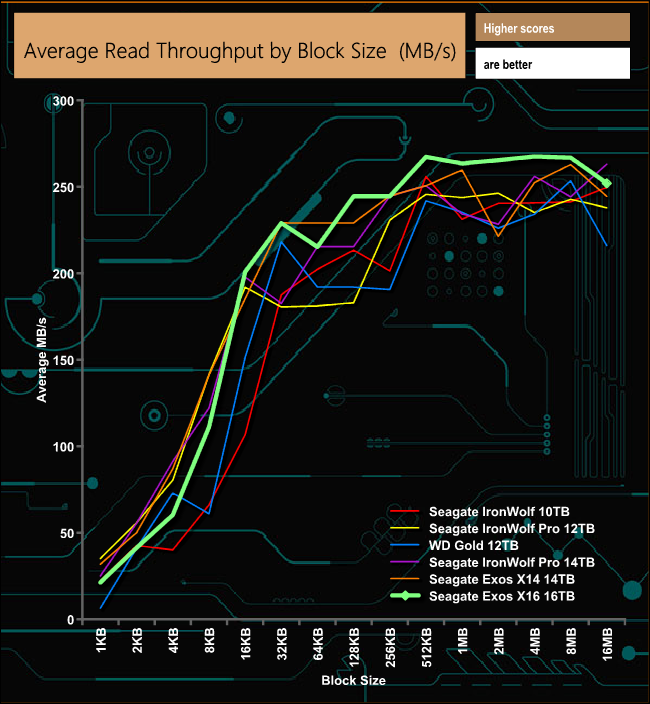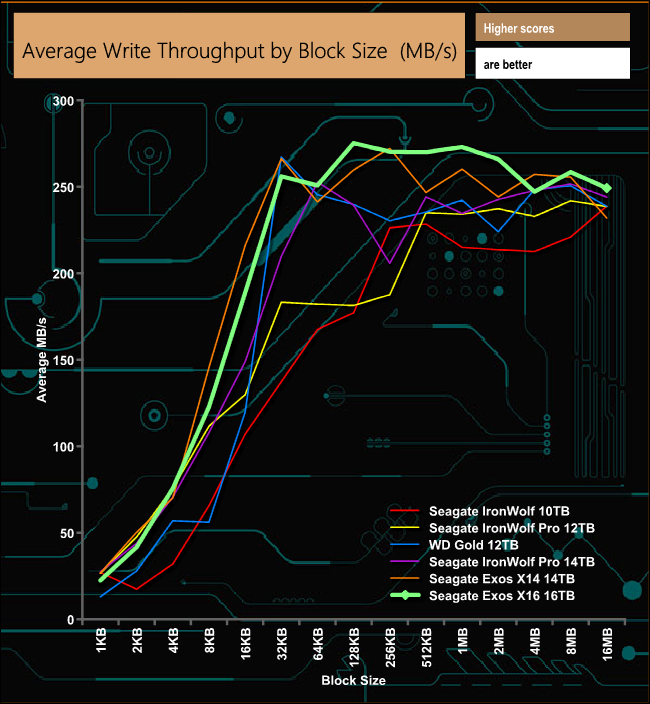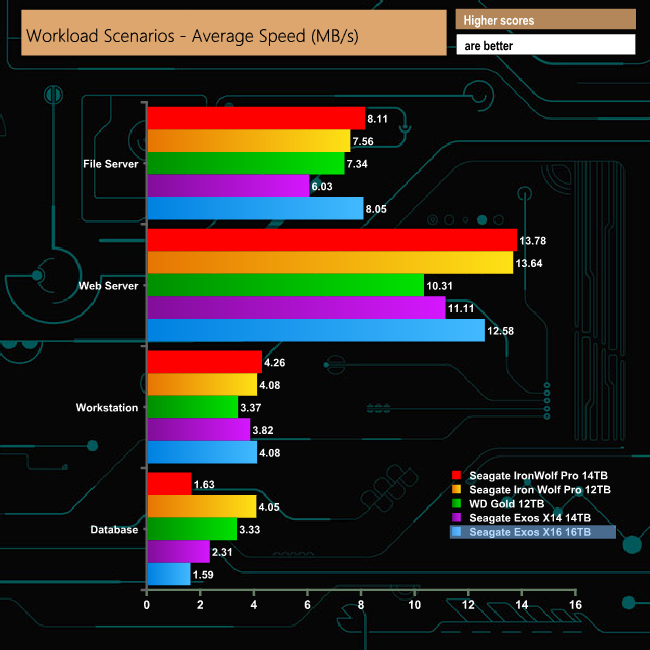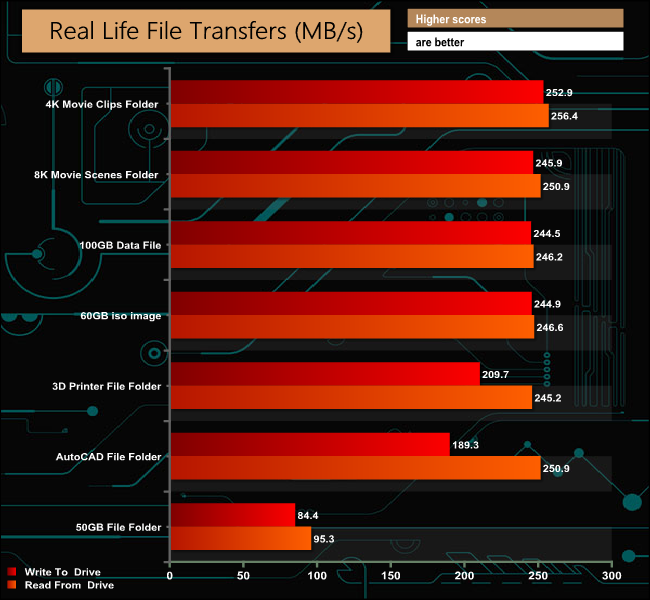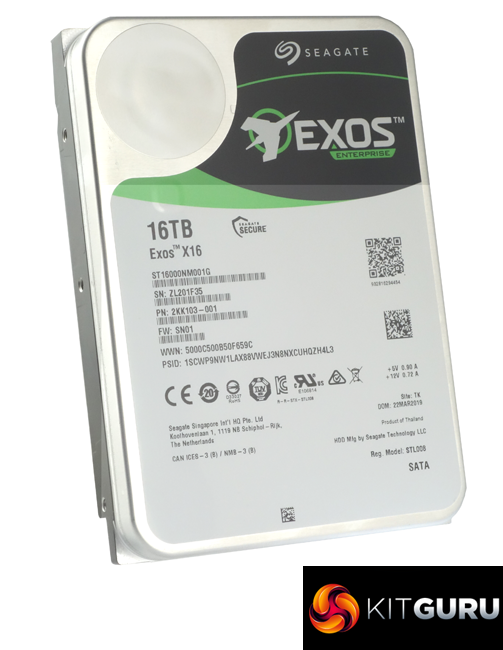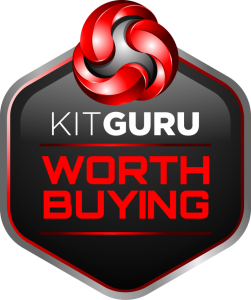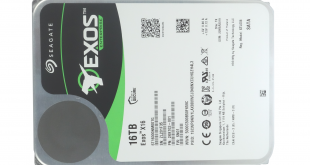
Seagate has recently refreshed the IronWolf and IronWolf Pro NAS product lines with new 16TB flagship drives. Launched at the same time was the new 16TB flagship drive for the enterprise range, the Exos X16. At launch, the Exos X16 drive is the world’s highest capacity 3.5-inch 7,200 RPM drive for the enterprise sector that is readily available.
The 16TB Exos X16 uses Helium technology which allows for 9 x 1.8TB (approx.) CMR (conventional magnetic recording) platters together with 18 TDMR heads to be crammed into a 3.5in format drive with a height of just 26.11mm. The drive has a spindle speed of 7,200rpm and is equipped with 256MB of cache. The official transfer rates for the Exos X16 are up to 261MB/s while the average latency is 4.16ms.
As with most of the Exos product range, the X16 is available with either 6Gb/s SATA or 12Gb/s SAS interfaces. There are two SATA models, the standard model (the drive we are reviewing here) which is the ST16000NM001G – and then there is a SED (Self-Encrypting Drive) version, the ST16000NM003G.
The three 12Gb/s SAS models are the ST16000NM002G (standard), ST16000NM004G (SED) and the ST16000NM009G (SED-FIPS (Federal Information Processing Standard) ).
Power ratings for the SATA drive are quoted as 5.W average idle with maximum read/write power figures of 10W and 6.3W respectively. Seagate quotes a workload rating of 550TB/year with a MTBF of 2.5M hours and back the drive with a 5 year warranty.
Physical Specifications:
- Usable Capacities: 16TB.
- Spindle Speed: 7,200rpm.
- No. Of Heads: 18
- No. Of Platters: 9
- Cache: 256MB.
- Recording Method: conventional magnetic recording (CMR)
- Interface: Serial ATA (SATA) 6Gb/s (SATA III).
- Form Factor: 3.5in.
- Dimensions: 26.11 x 101.85 x 146.99 mm
- Drive Weight: 690g
- Firmware Version: SN01
Seagate’s Exos X16 is built on a standard 3.5in format but with an enclosure thickness of 26.11mm. The drive has a spindle speed of 7,200rpm and 256MB of cache.


The drive uses Helium technology which enables Seagate to use nine 1.8TB CMR (Conventional Magnetic Recording) platters and 18 TDMR (Two-Dimensional Magnetic Recording) reading heads into the drive.
TDMR technology has come about because as the areal density of hard drive platters (discs) increases, tracks get ever narrower and as a result, magnetic inter-track interference (ITI) becomes problematic for the writer part of the drive head. TDMR uses two or more heads to read data from a single or even several nearby tracks at the same time to improve the signal-to-noise ratio delivered to the controller.
For testing, the drives are all wiped and reset to factory settings by HDDerase V4. We try to use free or easily available programs and some real world testing so you can compare our findings against your own system.
This is a good way to measure potential upgrade benefits.
Main system:
Intel Core i7-7700K with 16GB of DDR4-3200 RAM, Sapphire R9 390 Nitro and an Asus Prime Z270-A motherboard.
Other drives:
Seagate NAS 8TB
Seagate Exos X14 14TB
Seagate IronWolf Pro 14TB
Seagate BarraCuda Pro 12TB
Seagate IronWolf Pro 12TB
Seagate IronWolf 10TB
Toshiba N300 8TB
Toshiba P300 3TB
Toshiba X300 6TB
WD Gold 12TB
WD Black 6TB
WD Black 4TB
WD Red 8TB
WD Red 4TB
Software:
Atto Disk Benchmark.
CrystalMark 3.0.3.
IOMeter
All our results were achieved by running each test five times with every configuration this ensures that any glitches are removed from the results.
CrystalDiskMark is a useful benchmark to measure theoretical performance levels of hard drives and SSD’s. We are using V3.0.3. to test HDDs.
Although it's not mentioned on the spec sheet for the drive or in the features list, it appears that the Exos X16 – like the previous Exos X14 – uses Advanced Write Caching technology which boosts the random write performance of the drive, as can be clearly seen in the CrystalDiskMark write result.
The ATTO Disk Benchmark performance measurement tool is compatible with Microsoft Windows. Measure your storage systems performance with various transfer sizes and test lengths for reads and writes. Several options are available to customise your performance measurement including queue depth, overlapped I/O and even a comparison mode with the option to run continuously.
Use ATTO Disk Benchmark to test any manufacturers RAID controllers, storage controllers, host adapters, hard drives and SSD drives and notice that ATTO products will consistently provide the highest level of performance to your storage.
The new Exos X16 takes over top spot from the previous X14 drive in our ATTO results chart thanks to the additional platter that it uses.
IOMeter is another open source synthetic benchmarking tool which is able to simulate the various loads placed on hard drive and solid state drive technology.
We test with both random read and write 4k tests, as shown above. There are many ways to measure the IOPS performance of a hard drive, so our results will sometimes differ from manufacturer’s quoted ratings. We do test all drives in exactly the same way, so the results are directly comparable.
In our 4K random read/write tests, the drive is the fastest HDD drive we've tested to date – well, when it comes to write performance at least. Read performance on the other hand is the fifth best we've seen to date.
In our throughput test, reads peaked at the 4MB block size at 267.49MB/s before falling back to end the test at 252.04MB/s. Writes peaked at 275.23MB/s as the drive passes through the 128KB block size, before dropping back to finish the test at 249.25MB/s. Both of these peak figures confirm the official Seagate transfer rate for the drive of 261MB/s.
We tested the Exos X16 with a number of scenario’s that it may face in the real world. The settings for these scenarios are as follows.
File Server
512MB file size, 16KB Block size
80% Read 20% Write 100% Random
I/O queue depth 128
Web Server
1GB file size, 16KB Block size
100% Read 0% Write 100% Random
I/O queue depth 64
Database
2GB file size, 4KB Block size
90% Read 10% Write, 90% Random, 10% Sequential
I/O depth 128
Workstation
1GB file size, 16KB Block Size
70% Read 30% Write 50% Random 50% Sequential
I/O depth 64
In our workload tests, the Exos X16 is faster in all tests, bar the Database workload, than the previous X14 model. However, it still isn't as fast as the 14TB version of the NAS focussed IronWolf Pro drive in any of the tests.
To test real life performance of a drive we use a mix of folder/file types and by using the FastCopy utility (which gives a time as well as MB/s result) we record the performance of drive reading from & writing to a 256GB Samsung SSD850 PRO.
We use the following folder/file types:
- 100GB file
- 60GB iso image
- 50GB File folder – 28,523 files.
- 3D Printer file folder.
- AutoCAD File folder.
- 4K Movie Clip folder.
- 8K Movie Scenes folder.
The only time the Exos X16 fell below the 100MB/s bandwidth figure in our real life file transfer test was when it was dealing with the multitude of small files in the 50GB file folder transfer.
It's was less than a year ago when Seagate launched a 14TB version of the Exos enterprise drive, but yet here we are with another new flagship drive to raise the bar even higher, the 16TB Exos X16.
Designed for use with hyperscale applications/cloud data centres, high-capacity density RAID storage, mainstream enterprise external storage arrays or even centralised surveillance, Seagate’s new Exos X16 16TB drive delivers 33% more petabytes per rack compared to 12TB drives while maintaining the same small footprint for a reduced overall total cost of ownership.
While it is all well and good having racks and racks of drives offering colossal amounts of storage, the real challenge is to keep the power consumption and therefore the operating costs for said drives as low as possible. The Exos X16 has a couple of Seagate's technologies to help with this; PowerChoice and PowerBalance.
PowerChoice is Seagate’s own implementation of the T10/T13 Approved Standard and uses four step by step modes to enhance power savings while the drive is in idle periods longer than a second. Seagate claims that savings up to 54% can be made on drive power consumption in enterprise environments with PowerChoice technology.
Typically PowerChoice is enabled via a SATA Set Feature command (or via the SAS Mode Page for a SAS drive). This allows flexibility so that optimal idle times can be set for a particular storage application. Once the technology has been enabled it puts the drive into deeper and deeper idle power states the longer the drive is idle.
Seagate’s PowerBalance feature helps optimise the IOPS/Watt for even greater efficiency in environments with the focus on random read/write operations. These power saving features, coupled with the overall solid performance from the 16TB drive, make the Exos X16 a very good option for the data centre market.
If you choose the Self-Encrypting Drive (SED) version of the drive then a very usual tool for business/enterprise users comes into play – Seagate Instant Secure Erase (ISE). This technology, used in conjunction with Seagate's SeaTools utility, is designed to protect data on hard disc drives by instantly resetting the drive back to factory settings and changing the encryption key so that any data remaining on the drive is cryptographically erased – meaning that all the data on the drive is instantly and permanently unreadable.
We found Seagate's Exos X16 on Span.com for £595.20 (inc VAT) HERE.
Pros
- Huge capacity.
- Performance.
- Power saving features.
- 5-year warranty.
Cons
- Pricey.
KitGuru says: Seagate's latest monster of a hard drive for the enterprise sector comes less than a year after the last one, the 14TB Exos X14, and adds yet more capacity to Seagate’s enterprise range of hard drives.
Be sure to check out our sponsors store EKWB here
 KitGuru KitGuru.net – Tech News | Hardware News | Hardware Reviews | IOS | Mobile | Gaming | Graphics Cards
KitGuru KitGuru.net – Tech News | Hardware News | Hardware Reviews | IOS | Mobile | Gaming | Graphics Cards


